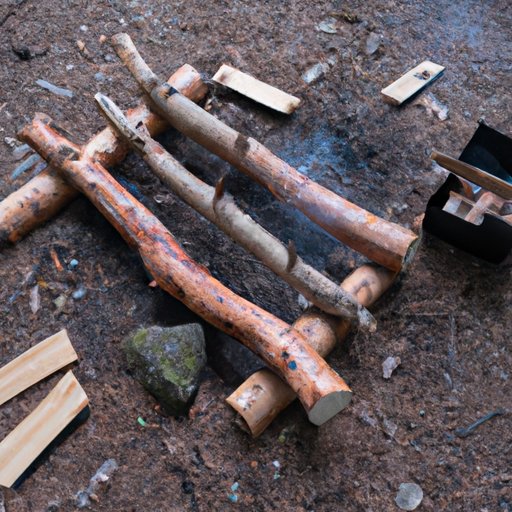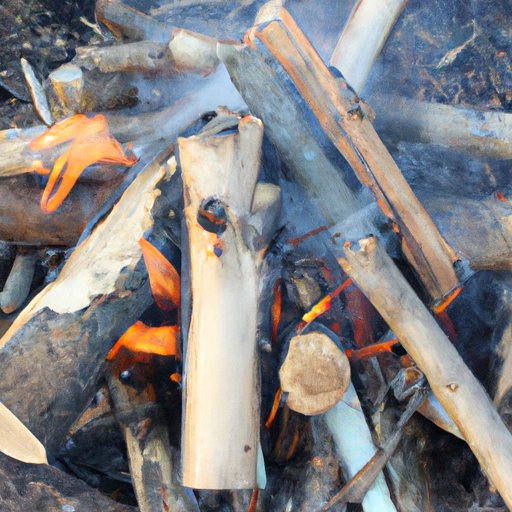I. Introduction
Starting a fire with firewood may seem like a simple task, but it can be a challenge for beginners. Without proper guidance and knowledge, it can take hours to get a fire going. This article provides a comprehensive guide on how to start a fire with firewood and offers tips for success. It covers the different techniques beginners can use, the essentials they need, and tips for starting a fire in wet conditions or using natural materials for survival situations.
II. 7 Steps to Master the Art of Starting a Fire with Firewood
Starting a fire involves more than just lighting a match and throwing it in a pile of wood. To do it right, there are specific steps to follow. This section outlines the seven fundamental steps:
Step 1: Choosing the Right Wood
Choosing the right type of wood is essential for starting and maintaining a fire. Hardwoods like oak, maple, and birch are ideal because they burn longer and produce more heat. Softwoods like pine, spruce, and cedar are best for kindling because they ignite and burn quickly.
Step 2: Gathering Materials
You will need kindling, paper, and firewood. Collect a variety of dry twigs, small sticks, and leaves for kindling. Use crumpled paper or dry grass to help get the fire started. Collect larger pieces of wood for the main fire to keep it burning consistently.
Step 3: Building the Fire Bed
The fire bed should be made of a non-flammable surface, such as rocks or concrete. Clear the debris, dust, or snow from the area, and make sure that the ground is level and dry. This provides a solid foundation for the fire and prevents hot coals from spreading.
Step 4: Setting Up the Kindling
The kindling should be arranged in a teepee or pyramid shape over the paper or dry grass. This will allow enough oxygen to reach the kindling and ignite it quickly. Make sure there is enough space between the kindling, allowing air circulation, and the fire can grow steadily.
Step 5: Setting Up the Firewood
Place the larger pieces of firewood around the kindling in a triangle or teepee shape. Build the fire slowly by adding more wood as the flames take hold in the kindling, and it shouldn’t ignite at once to avoid suffocating the fire.
Step 6: Lighting the Fire
Light the paper or dry grass with a flame, match, or lighter, and watch as the kindling catches fire. Tend to the fire by adding small pieces of wood to assure that it continues burning. Make sure to keep an eye on the fire at all times and never leave it unattended.
Step 7: Maintaining the Fire
Keep the fire burning by continually feeding it with small pieces of firewood. Make sure to keep the fire small, well-fed, and hot to prevent coals from catching fire. Adrenaline Junkie or uncontrolled fires are dangerous and should be avoided.
III. Basic Fire Starting Techniques for Beginners with Firewood
The Teepee, Log Cabin, and Lean-To methods are the most common fire starting techniques used by beginners. The Teepee method is simple and involves arranging kindling in a cone shape. The Log Cabin method involves alternating layers of kindling and firewood in a square or crisscross pattern. The Lean-To method uses a large piece of kindling leaning against another log or rock and placing smaller pieces of kindling against the main piece.
It’s crucial to use dry materials and adequately space the wood in any of these methods for success. Another way to reduce complexity is by using fire starters, small fuel sources that ignite the fire quickly. They can be made out of materials like wax or sawdust and can be purchased in stores or made at home.
IV. Fire Pit Essentials: Get Your Fire Started Using Firewood
To ensure success when using a fire pit, several essential items are required:
– Fire starters: additional lighting sources like matches or a lighter that are needed to start the initial fire.
– Kindling: small pieces of wood used for starting the fire and keeping it going.
– Firewood: larger pieces used once the fire has been established. Hardwoods burn longer, and softwoods ignite faster.
– Fire pit: suitable for safely containing the fire
– Fire tools: shovel, rake, and a pair of fire-resistant gloves are used to arrange the firewood and manage the fire.
V. 5 Ways to Start a Fire with Firewood without Matches or a Lighter
Matches and lighters are the handiest fire-starting tools. However, it’s essential to learn alternative techniques if you do not have matches or a lighter available. The following methods are lifesavers in survival situations:
– Flint and steel
– Magnifying glass
– Bow drill
– Glass bottle + water
– 9-volt battery
All of these fire starting techniques demand patience, research, and practice. However, this knowledge could be the difference between life and death in an emergency.

VI. The Ultimate Guide for Starting a Fire with Firewood in Wet Conditions
Starting a fire in damp conditions can be taxing because wet materials take longer to dry off. It’s important to prepare the materials appropriately and be patient in the process. Before getting started, choose a location that is protected from the elements such as caves or areas covered with rock. Here are a few tips for success:
– Find dry kindling materials
– Get good amounts of small sticks or twigs
– Create a teepee or a log cabin structure
– Build the fire underneath a natural shelter
VII. Survival 101: Starting a Fire with Firewood Using Natural Materials
Being able to start a fire with natural materials is an essential survival skill. Natural materials like bark, dry leaves, pine needles, or cotton balls are great for starting fires because they ignite quickly. Here are a few tips for identifying and using natural materials to start a fire:
– Identify the materials in your location
– Prepare the materials by removing excess water
– Bundle the materials with dry twigs or fabric
– Use dry materials to start the fire.
VIII. Conclusion
Starting a fire with firewood is a crucial skill, especially when outdoors. It impacts comfortability, warmth, and survival during emergency situations. Whether setting up a campfire or building a fire pit, understanding the fundamental steps and techniques can eliminate frustrations and prevent danger. The tips provided in this guide should give beginners the confidence they need to start a fire with firewood successfully.
(Note: Is this article not meeting your expectations? Do you have knowledge or insights to share? Unlock new opportunities and expand your reach by joining our authors team. Click Registration to join us and share your expertise with our readers.)
